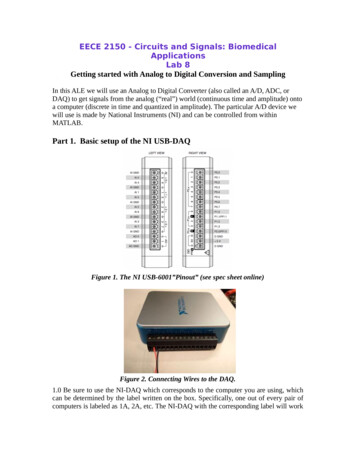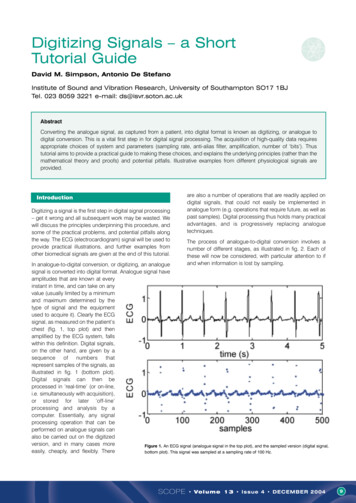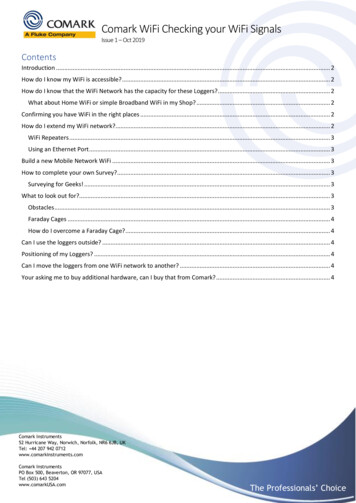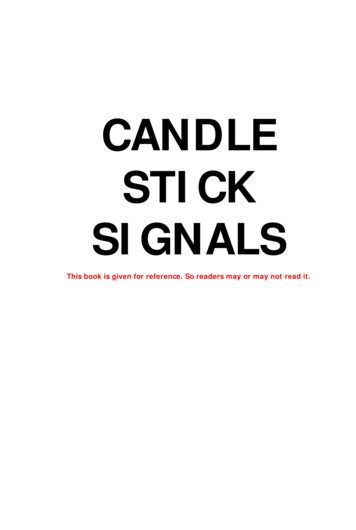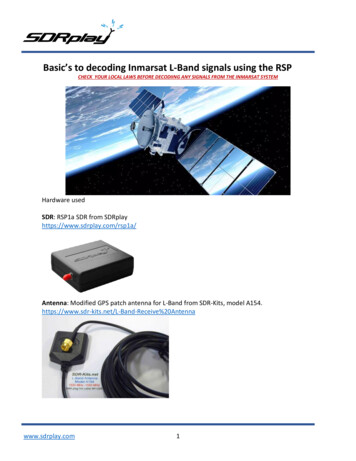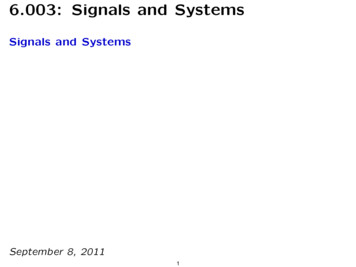
Transcription
6.003: Signals and SystemsSignals and SystemsSeptember 8, 20111
6.003: Signals and SystemsToday’s handouts: Single package containing Slides for Lecture 1 Subject Information & CalendarLecturer: Denny FreemanInstructors: Elfar AdalsteinssonRuss TedrakeTAs: Phillip NadeauWenbang XuWebsite: mit.edu/6.003Text: Signals and Systems – Oppenheim and Willsky2
6.003: HomeworkDoing the homework is essential for understanding the content. where subject matter is/isn’t learnedequivalent to “practice” in sports or musicWeekly Homework Assignments Conventional Homework Problems plusEngineering Design Problems (Python/Matlab)Open Office Hours ! Stata BasementMondays and Tuesdays, afternoons and early evenings3
6.003: Signals and SystemsCollaboration Policy Discussion of concepts in homework is encouragedSharing of homework or code is not permitted and will be re ported to the CODFirm Deadlines Homework must be submitted by the published due dateEach student can submit one late homework assignment withoutpenalty.Grades on other late assignments will be multiplied by 0.5 (unlessexcused by an Instructor, Dean, or Medical Official).4
6.003 At-A-GlanceThursdayFridayL1: Signals andSystemsR2: DifferenceEquationsHW1 R3: Feedback,due Cycles, and ModesL3: Feedback,Cycles, and ModesR4: CT SystemsL4: CT OperatorSep 20RepresentationsHW2 Student Holiday:due No RecitationL5: LaplaceTransformsR5: LaplaceTransformsSep 27 L6: Z TransformsHW3R6: Z TransformsdueL7: TransformPropertiesR7: TransformPropertiesL9: FrequencyResponseR8: Convolutionand Freq. Resp.TuesdayWednesdaySep 6Registration Day:No ClassesR1: Continuous &Discrete SystemsSep 13L2: Discrete-TimeSystemsOct 4L8: Convolution;Impulse ResponseEX4Oct 11Columbus Day:No LectureHW5L10: BodeR9: Bode DiagramsDiagramsdueR10: Feedback andControlOct 18L11: DT Feedbackand ControlHW6 R11: CT Feedbackdue and ControlL12: CT Feedbackand ControlR12: CT Feedbackand ControlExam 2HW7No RecitationL14: CT FourierSeriesR13: CT FourierSeriesL13: CT FeedbackOct 25and ControlExam 1No RecitationNov 1L15: CT FourierSeriesEX8dueR14: CT FourierSeriesL16: CT FourierTransformR15: CT FourierTransformNov 8L17: CT FourierTransformHW9 R16: DT Fourierdue TransformL18: DT FourierTransformVeterans Day:No RecitationNov 15L19: DT FourierTransformL20: FourierRelationsR17: FourierRelationsHW10Exam 3No RecitationNov 22 L21: SamplingEX11 R18: Fourierdue TransformsThanksgiving:No LectureThanksgiving:No-RecitationNov 29 L22: SamplingHW12R19: ModulationdueL23: ModulationR20: ModulationStudy PeriodFinal Exams:No-RecitationEX13 R21: ReviewL25: Applicationsof 6.003Breakfast withDec 13StaffEX13 R22: ReviewStudy Period:No LectureDec 20Finalfinals Examinations:finals No Classes finalsDec 6L24: Modulationfinals5finals
6.003: Signals and SystemsWeekly meetings with class representatives help staff understand student perspectivelearn about teachingTentatively meet on Thursday afternoonInterested? .6
The Signals and Systems AbstractionDescribe a system (physical, mathematical, or computational) bythe way it transforms an input signal into an output signal.signalinsystem7signalout
Example: Mass and Springx(t)y(t)x(t)y(t)tmass &springsystem8t
Example: Tanksr0 (t)h1 (t)r1 (t)h2 (t)r2 (t)r0 (t)r2 (t)ttanksystem9t
Example: Cell Phone Systemsound outsound insound insound outtcellphonesystem10t
Signals and Systems: Widely ApplicableThe Signals and Systems approach has broad application: electrical,mechanical, optical, acoustic, biological, financial, .x(t)y(t)mass &springsystemttr0 (t)h1 (t)r1 (t)r0 (t)r2 (t)h2 (t)tanksystemttr2 (t)sound insound outt11cellphonesystemt
Signals and Systems: ModularThe representation does not depend upon the physical substrate.sound outsound inE/M cell soundopticsound cell E/Mtowertowerinphone outfiberphonefocuses on the flow of information, abstracts away everything else12
Signals and Systems: HierarchicalRepresentations of component systems are easily combined.Example: cascade of component systemssoundinE/M cellopticcell E/MtowertowerfiberphonephonesoundoutComposite systemsoundincell phone systemsoundoutComponent and composite systems have the same form, and areanalyzed with same methods.13
Signals and SystemsSignals are mathematical functions. independent variable timedependent variable voltage, flow rate, sound pressurex(t)y(t)mass &springsystemtr0 (t)tr2 (t)tanksystemtsound intsound outtcellphonesystem14t
Signals and Systemscontinuous “time” (CT) and discrete “time” (DT)x[n]x(t)nt02468100246810Signals from physical systems often functions of continuous time. mass and spring leaky tankSignals from computation systems often functions of discrete time. state machines: given the current input and current state, whatis the next output and next state.15
Signals and SystemsSampling: converting CT signals to DTx(t)x[n] x(nT )nt0T 2T 4T 6T 8T 10T0246810T sampling intervalImportant for computational manipulation of physical data. digital representations of audio signals (e.g., MP3)digital representations of images (e.g., JPEG)16
Signals and SystemsReconstruction: converting DT signals to CTzero-order holdx(t)x[n]n02468t0102T 4T 6T 8T 10TT sampling intervalcommonly used in audio output devices such as CD players17
Signals and SystemsReconstruction: converting DT signals to CTpiecewise linearx(t)x[n]n02468t0102T 4T 6T 8T 10TT sampling intervalcommonly used in rendering images18
Check YourselfComputer generated speech (by Robert Donovan)f (t)tListen to the following four manipulated signals:f1 (t), f2 (t), f3 (t), f4 (t).How many of the following relations are true? f1 (t) f (2t)f2 (t) f (t)f3 (t) f (2t)f4 (t) 13 f (t)19
Check YourselfComputer generated speech (by Robert Donovan)f (t)tListen to the following four manipulated signals:f1 (t), f2 (t), f3 (t), f4 (t).How many of the following relations are true? 2 f1 (t) f (2t)f2 (t) f (t) Xf3 (t) f (2t) X f4 (t) 13 f (t)20
Check Yourselff (x, y) 2500250y 250250x 2500250f1 (x, y) f (2x, y) ?x2500 2500 250 2500250How many images match the expressions beneath them?yy250y0 2500250xf2 (x, y) f (2x 250, y) ?21 2500250xf3 (x, y) f ( x 250, y) ?
Check Yourself0f (x, y)250x 2500250xf1 (x, y) f (2x, y) ?2500 2500 2500 2500 250 250y250y250y250y 2500250x 2500250xf2 (x, y) f (2x 250, y) ? f3 (x, y) f ( x 250, y) ? x 0 f1 (0, y) f (0, y)x 250 f1 (250, y) f (500, y)x 0 f2 (0, y) f ( 250, y)x 250 f2 (250, y) f (250, y)x 0 f3 (0, y) f ( 250, y)x 250 f3 (250, y) f ( 500, y)22X XX
Check Yourselff (x, y) 2500250y 250250x 2500250f1 (x, y) f (2x, y) ?x2500 2500 250 2500250How many images match the expressions beneath them?yy250y0 2500250xf2 (x, y) f (2x 250, y) ?23 2500250xf3 (x, y) f ( x 250, y) ?
The Signals and Systems AbstractionDescribe a system (physical, mathematical, or computational) bythe way it transforms an input signal into an output signal.signalinsystem24signalout
Example System: Leaky TankFormulate a mathematical description of this system.r0 (t)h1 (t)r1 (t)What determines the leak rate?25
Check YourselfThe holes in each of the following tanks have equal size.Which tank has the largest leak rate r1 (t)?1.2.3.4.26
Check YourselfThe holes in each of the following tanks have equal size.Which tank has the largest leak rate r1 (t)? 21.2.3.4.27
Example System: Leaky TankFormulate a mathematical description of this system.r0 (t)h1 (t)Assume linear leaking:r1 (t)r1 (t) h1 (t)What determines the height h1 (t)?28
Example System: Leaky TankFormulate a mathematical description of this system.r0 (t)h1 (t)r1 (t)Assume linear leaking:r1 (t) h1 (t)Assume water is conserved:dh1 (t) r0 (t) r1 (t)dtSolve:dr1 (t) r0 (t) r1 (t)dt29
Check YourselfWhat are the dimensions of constant of proportionality C? dr1 (t) C r0 (t) r1 (t)dt30
Check YourselfWhat are the dimensions of constant of proportionality C?inverse time (to match dimensions of dt) dr1 (t) C r0 (t) r1 (t)dt31
Analysis of the Leaky TankCall the constant of proportionality 1/τ .Then τ is called the time constant of the system.dr1 (t)r0 (t) r1 (t) dtττ32
Check YourselfWhich tank has the largest time constant τ ?1.2.3.4.33
Check YourselfWhich tank has the largest time constant τ ?1.2.3.4.344
Analysis of the Leaky TankCall the constant of proportionality 1/τ .Then τ is called the time constant of the system.dr1 (t)r0 (t) r1 (t) dtττAssume that the tank is initially empty, and then water enters at aconstant rate r0 (t) 1. Determine the output rate r1 (t).r1 (t)time (seconds)123Explain the shape of this curve mathematically.Explain the shape of this curve physically.35
Leaky Tanks and CapacitorsAlthough derived for a leaky tank, this sort of model can be used torepresent a variety of physical systems.Water accumulates in a leaky tank.r0 (t)h1 (t)r1 (t)Charge accumulates in a capacitor.iiio v Ci iodv i i i iodtCanalogous to36dh r0 r1dt
MIT OpenCourseWarehttp://ocw.mit.edu6.003 Signals and SystemsFall 2011For information about citing these materials or our Terms of Use, visit: http://ocw.mit.edu/terms.
Engineering Design Problems (Python/Matlab) Open Office Hours ! Stata Basement Mondays and Tuesdays, afternoons and early evenings. 3. 6.003: Signals and Systems . Collaboration Policy Discussion of concepts in homework is encouraged Sharing of homework or code is not permitted and will be re ported to the COD Firm Deadlines Homework must be submitted by the published .
